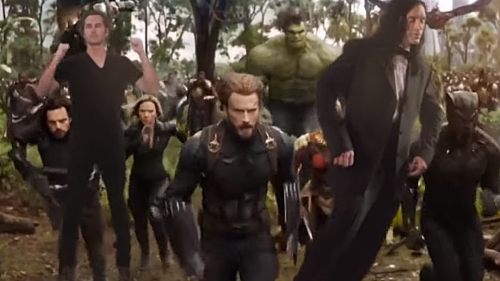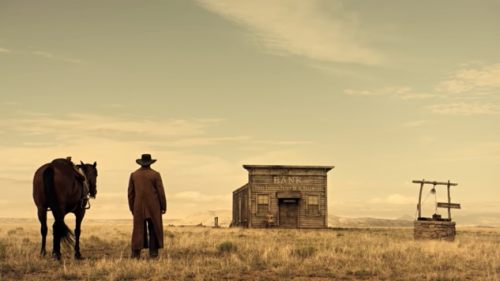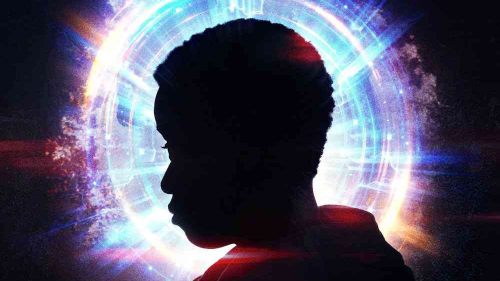THE DISASTER ARTIST: A Game Of Expectations
As a ten-time attendee of The Room at midnight, alow me to confirm your suspicions: this decade old spoon throwing ritual is aimed largely at turning actor-director-writer-producer Tommy Wiseau into a pariah. Sometimes it feels justified, with audiences spending a significant portion of the runtime lamp-shading the film’s absurd misogyny. Other times it walks a fine line between making fun of a piece of outsider art for its ego-driven ineptitude, and making fun of an outsider artist for being an outsider. Chances are I don’t need to explain the modern appeal of Tommy Wiseau since you’re reading this on the internet. He’s an easily meme-able quip machine with unknown origins and seemingly oblivious views on everything from fashion to video games. You know this. I know this. Tommy may or may not know this, but one person who seems to know it all too well is The Disaster Artist star and director James Franco, who approaches Tommy’s tale with both unabashed sincerity and what might be a stroke of egotistical genius:
James Franco doesn’t care if you don’t empathize with Wiseau. In fact, he’s counting on it. All that matters is James Franco empathizes with Wiseau.
As much as The Disaster Artist is a re-telling of events that led to The Room, it’s also a character piece and a tribute to Franco’s kindred spirit, a writer with high-minded literary ambitions and a fellow performer whose dreams were forged in the flames of Mount Dean. Franco, a keen adapter of Faulkner and Steinbeck, played the role of acting idol in James Dean, the 2001 TV biopic. Wiseau, a devotee of Tennessee Williams, famously channeled Dean in The Room with “You’re tearing me apart,” a reference to Rebel Without a Cause. Upon re-watching Rebel, Dean’s penultimate role even plays like the blueprint for Wiseau’s quirks as a performer. These are two modern actor-directors consonantly swinging for the fences, one connecting far more often than the other. Only for every time Franco failed (take 2005’s The Ape, his self-indulgent directorial debut), he was afforded new opportunities as someone who could mold himself to fit Hollywood’s definition of “normal” in between artistic. Wiseau had no such luxury before or after The Room, but the two ultimately come from the same creative spark, and the same dilemmatic desire to fit in by standing out.
Franco does a spot-on Wiseau in The Disaster Artist, and his imitation is all flattery. It comes from the inside out. He introduces us to Wiseau by embodying his reckless theatrical abandon, scaling the walls of his acting class and flailing about in a desperate attempt to remix A Streetcar Named Desire. It’s a ridiculous display, but Franco never winks. Instead, he crafts a humane portrayal of someone all too easy to imitate.
The Disaster Artist could so easily have turned into farce. That’s what many of us assumed it would be when the project was first announced, and that presumption is carried through the entire production as Franco leans in to the idea by casting a who’s who of great American and Canadian comedic talents. His brother Dave plays Tommy’s best friend and Disaster Artist author Greg Sestero, a good-looking Hollywood novice. Long-time collaborator Seth Rogen plays Tommy’s script supervisor and on-set adversary. Zac Efron, Alison Brie, Bob Odenkirk, Megan Mullaly, and even Judd Apatow show up in not insignificant roles, and they all clash with Tommy at one point or another, either directly or by talking about him behind his back. The Disaster Artist is hilarious in parts (there’s nothing quite like Franco channeling Wiseau’s insistence of having to “show his ass to sell the movie”), but it’s not what I’d call an outright comedy, at least in the mainstream American sense of the word, even if wears the skin of one. You could swap any number of these names for someone more likely to be found in a “prestige picture”’ and you could get away with telling the same basic story. These people were not hired to be funny, but their presence goes a long way to making you think that’s the case.
The film has all the technical makings of a great drama. There’s warmth to how Tommy and Greg are lit, as the camera works to discover the interplay between the characters and their relationships to their surroundings, moving subtly and musically between the Franco brothers as a pair of diametrically opposed besties with dreams of stardom. Like the real Wiseau, Franco’s English here lacks pluralities, tenses and definite articles. His accent is vaguely Eastern European, and his easily mimic-able laugh shows up on more than one occasion, sounding as fake as you’d expect, yet somehow never feeling as such. Wiseau’s artificial texture becomes just that, an unwitting mask for an inexplicable sincerity matched in kind by the film. Its all-star comedy roster and their reactions to Wiseau position him as the clown and Franco makes sure to highlight their responses in the edit, as if every confused stare ought to be accompanied by a record scratch. Most of the time however, what Franco does or says isn’t played for comedic effect.
When Wiseau laughs to himself every time he calls Greg “baby face,” he really is laughing at his own term of sincere endearment. When he’s on the verge of torpedoing the production because he’s too conceited to provide water, he really does think that’s how a set is supposed to run. It’s just how Tommy sees the world. It’s just how Tommy speaks. It’s just how Tommy reacts to the people around him. Franco’s performance feels expressionistic despite being steeped in naturalism, because that’s just who Tommy is: sn outsider with an American dream, constantly told he’ll never fit in. To whatever degree James Franco does or doesn’t relate, he works to embody Wiseau’s every glance and every slight moment of self-realization, nestling subtleties amidst a treasure trove of ridiculous gestures.
As we’re drawn further into Tommy’s headspace, the reaction shots of onlookers start to feel less like comedic punctuation, and more like a mirror held up to the audience. But as we become more and more invested in Tommy, his dreams, his desires and his shortcomings, the film’s comedic pretense refuses to cease. Well-known comedic actors continue to appear in bit roles one after another, as if to challenge our responses as we learn adjust them. Paul Scheer. Jason Mantzoukas. Hannibal Burress. Even Nathan Fielder, who plays the ultimate American-dream-pursuing outsider in Nathan For You, gets to talk about Tommy behind his back as one of his co-stars. They all show up to mock the elusive director, not through scripted jokes or their respective forms of improvised witticism, but by simply refusing to engage with him on a human level. They condescend without ever being funny about it. In fact, they’re downright mean in ways that Tommy can’t even pick up on. These actors usually inhabit the role of the outsider elsewhere. They’re the “weird” ones who play slightly off-beat Americans (and non-Americans), but they’re eventually accepted by Hollywood for the acts they put on. Tommy on the other hand, can’t switch back to “normal” by American standards. He is the outsider all American comedians play.
Like The Room itself, watching The Disaster Artist on opening night in America with a whole bunch of Room fans was a bizarre experience. Most of them were clearly there because they enjoyed making fun of Wiseau (some even brought plastic spoons, which is a huge no-no in this context), and every line of dialogue out of Franco’s mouth was met with laughter for a good half hour. But as time went on, and as Franco opened up his heart and humanized a man that so many could only see as caricature, the film became akin to a metatextual litmus test. As an outsider to American society, sitting in that theatre quite literally off in a corner, I found myself constantly engaged with Franco’s Wiseau, a man being laughed at for his accent and for his lack of American pop-culture knowledge. These were jokes to much of the audience, but in that moment, I felt the same kinship with Wiseau and Franco did. He wasn’t playing an idiot, no matter how much the extras around him were directed to react as such as he performed The Tempest in an American diner. Franco may play a man with a massive ego, but he also plays a man whose only real desire is to be a part of the coveted American normality through both art and friendship, despite being told he doesn’t fit the image of either.
As Wiseau’s narrative became clearer in the film, the opening-night audience began to change its tune. Sniggers anytime Franco recreated a familiar Wiseau-ism were soon replaced with audible “aww”s. The camera closes in on Wiseau’s puppy-dog eyes in a scene that feels pivotal, testing the audience’s threshold for bold-face sincerity as he stands on his LA rooftop, having just been told he’ll never make it. He confesses his inner feelings to his best friend Greg. His fears. His goals. His isolation. The emotional toll of everyone’s mockery comes pouring out. Together, in that moment, Tommy and Greg claim to stop caring what anyone else thinks.
It’s a moment of temporary catharsis; a minor victory before Wiseau’s collapse into his own hubris, as Franco entices the audience into empathizing by having Tommy impulsively reject his desire for empathy. His wanting to stand on his own despite our knowledge that he can’t is reason enough to care. It isn’t even fair to say he becomes a markedly worse person once he gains the audience’s favour, given how he treats his crew. His desire to be free from wanting the approval of others is as strong as the fact that he can’t help but crave it. None of us can.
Franco’s Wiseau speaks with the same broken English in his confession to Greg, with the same signature ticks and with the same inexplicable accent. Nothing about him had changed, but on opening night, this scene no longer felt like a point of ridicule for the audience I was with. They’d seen the effect mocking laughter had on him. This was the moment he decided to make THE ROOM, one of the worst films of all time and a major reason most of these people had shown up to in the first place. But rather than continuing to snark at his strangeness and laugh in ways they’d been conditioned to, people seemed to understand him. Suddenly, there was a struggle taking place in every seat now that Wiseau’s weirdness has been put into context – not by explaining where he came from or why he speaks the way he does, but simply by portraying the effect of being othered, justified or not. Where a toned-down Wiseau in a film with a veneer of seriousness would’ve worked as a straightforward story, Franco’s own reckless abandon in a film designed to turn the camera back on its audience has a more introspective quality. It plays like a joke you’ve heard a million times, only this time you’re face to face with the subject of its punchline.
I can’t say how the film will play to folks unfamiliar with The Room (they’ll be treated to a Franco performance on par with his gonzo work in Spring Breakers regardless), but what I can say is this: The Disaster Artist works towards contextualizing a pariah, and succeeds at humanizing him despite never going beyond what we presume at the outset. An outsider eventually being accepted is the kind of tale American cinema revels in, but rarely has there been a film that leaves its outsider further on the outskirts than where he began. What’s more, it plays it off like the ultimate victory. Few have ever done what Wiseau has, intentionally or not, and even fewer have garnered a response so riotous that every new wave of Room fans is afraid of the circle growing too wide and the film losing its niche appeal. In an America increasingly focused on cultural homogeneity, difference to the point of ridicule may as well be a mark of greatness.
The Disaster Artist is the kind of story only a fellow artistic outsider like James Franco could’ve told. Given his 2013 piece on Wiseau for Vice, it feels like it was meant to be:
“This is the deeper level of Tommy: he is just a lonely little boy who wants love. He, like so many people with stars in their eyes, sees film not only as a medium of expression, but the gate to acceptance. It is the place where his work will find like-minded people who will learn to love him through his work, not only because of it. This is the hope of most artists, and the book turns Tommy’s sometimes ridiculous struggle into a paradigm for those wishing to be creative in a world where it is usually too hard to be.
In so many ways, Tommy c’est moi.”



